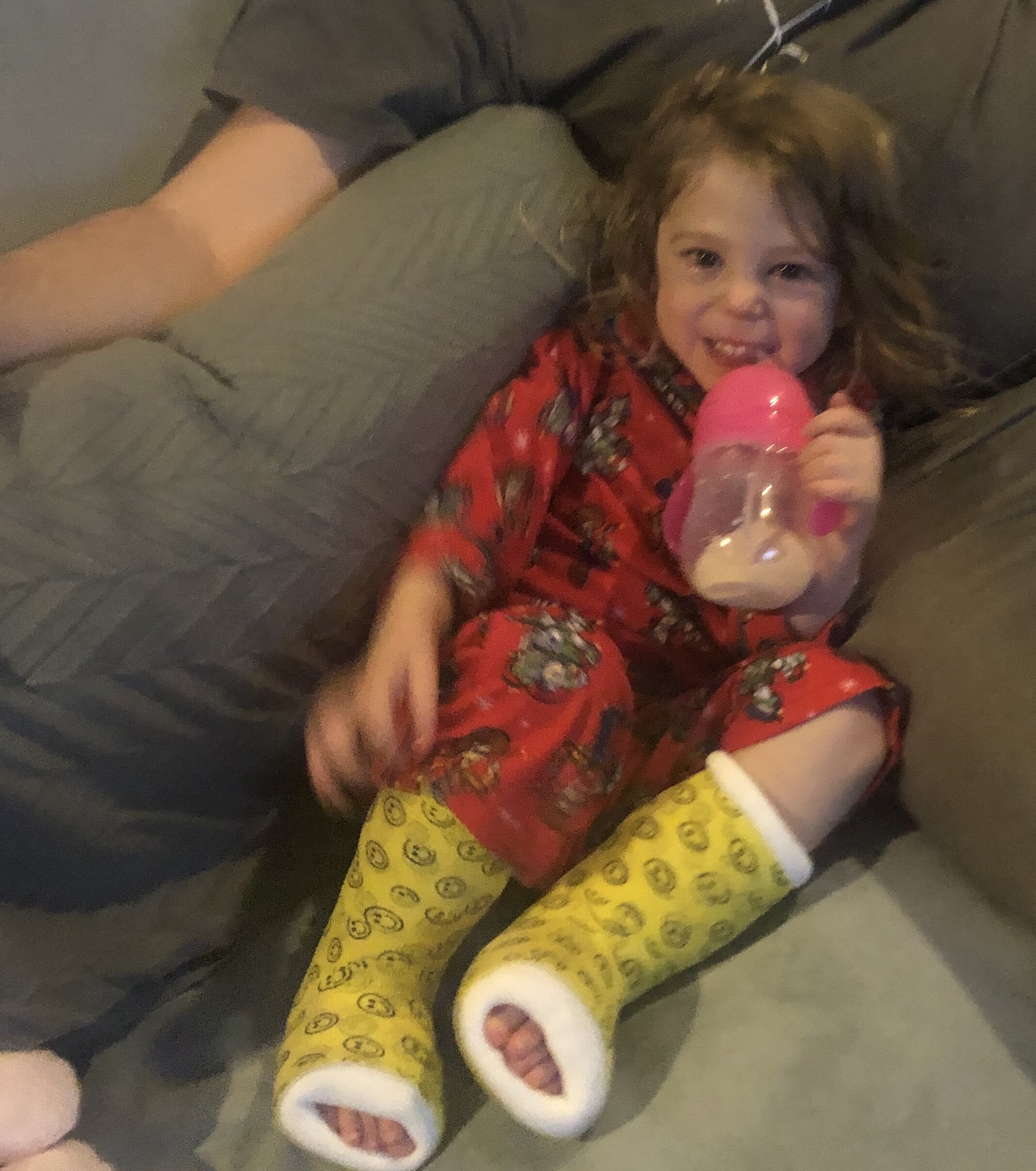
Sophie’s Health Journey
At the age of 15 months Sophie was not able to stand up on her feet. When we tried to aid her we were met with cries and fussing. We didn’t know if her whines were just “baby stuff,” but it seemed like she was in pain.
She taught herself to walk on her knees by then. By 18 months, nothing had improved but we had already started down our investigative path.
She underwent a gamut of tests and doctor visits including genetic microarray testing, X-rays of her hips, legs and feet, visits with orthopedics, as well as ENT to check her vestibular system and hearing. She also began physical therapy and occupational therapy weekly.
An x-ray of her foot showed inflammation in her ankles as well as an underdevelopment in the talus bone in her right foot. For awhile we thought her feet looked like little chubby baby feet, and missed the signs of inflammation. We had noticed her right foot seemed to slightly point inwards and the x-ray depicted this anomaly. The inflammation piece was the cue to send us to rheumatology at Children’s Hospital Colorado, where Sophie was diagnosed with Juvenile Idiopathic Arthritis at the age of 22 months.
Treating Arthritis
We all fell in love with Sophie’s Rheumatologist at Children’s Hospital Colorado, Dr. Jenny Soep, and we were encouraged by her wonderful optimistic nature. We were pleased to learn of a gamut of available treatments and therapies effective in managing arthritis discomfort and inflammation. Her medical plan of care was working. Within 2 months of immunosuppressive therapy, combined with wearing Ankle-Foot braces (AFOs) daily, and weekly Physical Therapy and Occupational Therapy [thank goodness for the Imagine! Foundation in Colorado and her amazing therapists at Kidspot Pediatric Therapies] , Sophie was walking unassisted one week before she turned 2 years old.
The journey to this point had already been rough, filled with continuous poking and prodding with regular labs and blood draws, multiple doctor visits requiring over an hour drive from home, not to mention weekly PT and OT, weekly medication injections, plus bracing and casting to try to work on the deformity that still remains in her feet. A medical procedure to administer steroids directly to her joints, and the addition of an iL-6 inhibitor (Actemra) had Sophie feeling better than ever, before the age of 2.5 years old.
She was finally walking with confidence, despite a funny gait, and she even started running. She was almost entirely pain free, despite a couple brief moments of joint pain each day. Even though the treatments seemed to be working, the deformities in her feet and abnormally developing bones kept the doctors scratching their heads. There was a missing link.
Genetics
We had been on a wait list for a whole year to see a genetic counselor at Children’s Hospital Colorado. We finally got in, November 18, 2019. At this point, we were hoping genetics was a box to check off and move on. We hoped we were on our way to treating arthritis. One look at Sophie and the genetic counselor said we should enter one of the most extensive screenings available. Whole Exome Sequencing (WES). Sophie and both parents submitted bio specimens, and 2 months later Sophie’s corrected diagnosis was confirmed: MCTO. The geneticists looked like they had seen a ghost as they delivered the information. They didn’t know anything about the condition, other than the scary reality of what was published in the incomplete medical papers they had dug up and what was reported in her genetic test. We were told she was one out of only 30 other people in the world identified with the disorder. And despite how much wonderful progress she had made over the previous year, she would likely end up crippled in her hands, feet and potentially other joints, and probably would lose the ability to walk again. Further her kidney’s were dysfunctional and she might need a transplant one day as the deterioration inevitably will progress without an effective intervention. We were told the mutation occurred in her own genetic make up and it wasn’t passed along from mom or dad, but, and that Sophie would have a 50% chance of passing it on to her future offspring. That was all the information we had to work with. At that very moment, we knew our work was cut out for us. We were not going to sit on the sidelines and let this play out. Within 72 hours of receiving the diagnosis Sophie’s Neighborhood had launched.
Exhaustive Research & More Appointments
We started reading through the medical papers and reached out to the doctors and scientists, and authors of the literature availble. Shriner’s Children’s Research Hospital in St. Louis had seen ~ 10 patients in the past identified with the disorder. Immediately we booked appointments to travel there (although appointments were delayed due to the COVID-19), only to be left with little hope from that visit for the future of treating this disease. Thankfully we found that locally in Colorado we were in very capable hands to begin our path to first addressing Sophie’s symptoms, and maybe even slowing down the progression of the disease. We saw docs at Children’s Hospital Colorado in all the relevant disciplines: endocrinology, nephrology, rheumatology, hematology, orthopedics, even cardiology for a full health overview. Although none of these specialists had seen this particular ultra rare disease, we knew with their support we could help Sophie to the best of our ability here, while we dedicated ourselves to advancing research. We were fortunate that a new group had formed at Children’s Colorado consisting of each of the specialists most relevant to Sophie’s condition in the Bone and Mineral Metabolism clinic. We were thrilled to be able to meet “Ed and Jeannette Kerr Family Endowed Chair” in Endocrinology, the Director of the department right away, Dr. Nina Ma, who soon after became a member of our Scientific Advisory Board. Sophie was seen as one of the first cases in the multi-disciplinary BAMM clinic the same year it began.
We were in touch with a researcher in Australia who had been focused on a mouse model for MCTO until funding ran out and he had to stop his work. We were grateful when he told us he, as well as his mouse model partner in Japan, Dr Satoru Takahashi, would resume MCTO mouse work if there were resources raised to dedicate to it.
We reached out to family, friends, friends of friends, colleagues, and anyone that would connect with us from a medical, scientific or fundraising standpoint. We got MORE HELP THAN WE COULD HAVE EVER IMAGINED. Most notably we were lead to the wonderful founder, chairman and former CEO of SomaLogic, Larry Gold, a unique proteomics and health information company located in our backyard of Boulder, CO. We are currently working with Dr. Gold to look beyond the genetic mutation to understand the biology underlying it and find a target for an MCTO treatment. We formed a team of incredible scientific advisors from biotech companies, to academic institutes across the country, and began our research plan together.
Present and Hopes for the Future
Today, at the age of 5 years old Sophie is fairly pain-free (and her parents try not to remain anxious for that next “shoe to drop” in this progressive disease.) She experiences sensitivities around her wrists, ankles and knees that cause momentary pain. She cannot climb stairs or play on typical park structures unassisted, but she tries! Her feet fatigue so quickly that she needs a long break after walking a couple of blocks.
Her x-rays continue to show unusual, misshapen bones, bone deterioration, and the absence of bones you would expect to see at this age. Her renal function is abnormal, and she is taking medications to protect her kidneys from proteinuria that could get so advanced in her future it can lead to end stage renal failure.
We are determined to drive momentum behind continued research, to get smarter and more knowledgeable , advocate and fundraise as much as humanly possible, and we will not stop our work. We are now working closely with Dr Takahashi, our mouse model partner at the University of Tsukuba in Japan, in addition to another group known for excellence in mouse studies here in the US, at the Jackson Labs. Additionally, studies are underway with kind partners at biotech Boulder/Denver- based companies, like Artisan Bio, SomaLogic and Arpeggio. Our funding has extended institutes such as Stanford University, Univ of Tsukuba, Children’s Hospital of Philadelphia, Children’s Hospital Colorado, Harvard University and more - all helping us make strides in updating our current knowledge for MCTO and a pathway to a treatment.
The clock is ticking for Sophie and and the others with this progressive disease. We have dedicated our lives to seeking help through research advised by our science team, conducted by experts interested in seeking a treatment or cure for MCTO with us.
We only hope you will continue to help us along this journey, as we cannot do it alone. We are the only group dedicated to fundraising for research for MCTO. Your support will make a direct impact on the lives of children who need it beyond imagination. YOU WILL AND CAN make a difference!
Serial Casting to encourage the feet to a normal position, followed by removable night splints for the feet and wrists. Jan-Feb 2020.
Wrist splints enable more comfort and a nice stretch, in an effort to sooth her wrists as stiffness increases. March 2020.
This is Sophie’s “miracle window.” Which means we have her diagnosis, but her symptoms are not yet too severe and she doesn’t experience persistent pain. We are working with urgency to help her before it is too late to reverse the crippling effects unwinding as her body grows.
Right foot has always been more affected.
First time walking without the assistance of a walker, or a person to hold her hands, or any other support. 1 week before 2nd birthday, May 22, 2019.
Sophie at the age of 5. She’s a trooper and her daily life includes lots of therapy, medications that try to address her symptoms, day and night braces, visits with specialists that relate to each discipline this disease touches. She’s strong and resilient and a super hero!







